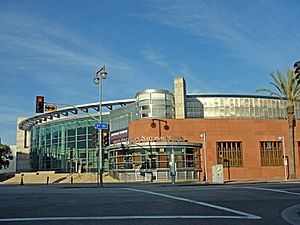Japanese American facts for kids

|
|
| Total population | |
|---|---|
| 773,714 0.2% of the total U.S. population (2018) |
|
| Regions with significant populations | |
| Hawaii, the West Coast and urban areas elsewhere. | |
| Languages | |
| American English, Japanese and Hawaiian Pidgin | |
| Religion | |
| 33% Protestantism 32% Unaffiliated 25% Buddhism 4% Catholicism 4% Shinto |
|
| Related ethnic groups | |
| Japanese people, Ryukyuan Americans |
Japanese Americans (Japanese: 日系アメリカ人, Hepburn: Nikkei Amerikajin) are Americans who have full or partial Japanese heritage. They are people who connect with their Japanese background and culture. For a long time in the 20th century, Japanese Americans were one of the three largest Asian American groups. But by the year 2000, their numbers had changed. They became the sixth largest Asian American group, with about 773,000 people, including those with mixed heritage.
In 2010, the biggest groups of Japanese Americans lived in California (272,528 people) and Hawaii (185,502 people). Other large communities were found in New York (37,780), Washington (35,008), Illinois (17,542), and Ohio (16,995). The area of Southern California has the largest Japanese American population in North America. The city of Gardena has the most Japanese Americans living close together in the main 48 states.
Contents
A Look at Japanese American History
Japanese Americans have a rich and sometimes challenging history in the United States. Their journey began with early immigrants seeking new opportunities.
Early Immigration and Life
The first large groups of Japanese immigrants came to the U.S. in the late 1800s and early 1900s. Many came to Hawaii to work on sugar plantations. Others came to the mainland, especially California, to work in farming or fishing. These early immigrants faced many difficulties, including laws that limited their rights. They often created their own communities, called "Japantowns" or Nihonmachi, where they could keep their culture alive.
World War II and Internment
One of the most difficult times for Japanese Americans was during World War II. After the attack on Pearl Harbor in 1941, many Americans worried about people of Japanese descent. Even though most Japanese Americans were loyal U.S. citizens, the government ordered about 120,000 people to be moved to special camps. These camps were called "internment camps." Families lost their homes, businesses, and freedom. This was a very unfair time in American history. Later, the U.S. government apologized for this action.
Building a Future
After World War II, Japanese Americans worked hard to rebuild their lives. They continued to contribute greatly to American society. They became successful in many fields, like science, arts, business, and politics. Their strong family values and focus on education helped them overcome past challenges.
Japanese American Culture and Traditions
Japanese American culture is a unique blend of Japanese traditions and American life. Many families keep their heritage alive through festivals, food, and language.
Festivals and Celebrations
Japanese Americans celebrate many traditional Japanese festivals.
- Obon: This summer festival honors ancestors. People dance and enjoy food.
- Nisei Week: In Los Angeles, this festival celebrates Japanese American culture and history. It includes parades, music, and food.
- Tanabata: Also known as the Star Festival, people write wishes on paper and hang them on bamboo.
Food and Family Life
Food plays a big role in Japanese American culture. Many families enjoy traditional Japanese dishes like sushi, ramen, and teriyaki. They also have their own unique dishes that mix Japanese and American flavors. Family is very important, and many traditions are passed down through generations.
Language and Arts
While many younger Japanese Americans speak English, some also learn Japanese. Traditional arts like calligraphy, origami, and martial arts are also popular. Japanese American artists, writers, and musicians have created amazing works that share their unique experiences.
Notable Japanese Americans
Many Japanese Americans have made important contributions to the United States and the world.
- Yoichiro Nambu: A brilliant physicist who won the Nobel Prize in Physics in 2008.
- Miné Okubo: A talented artist and writer who documented her experiences in the internment camps.
- Midori Goto: A world-famous violinist who started playing at a very young age.
- Ford Konno: An Olympic swimmer who won gold medals in 1952.
- Miyoshi Umeki: An actress and singer who won an Academy Award in 1957.
These individuals, and many others, show the diverse talents and achievements of the Japanese American community.
Images for kids
-
Families of Japanese ancestry being removed from Los Angeles during World War II
-
Anti-Axis Committee headquarters in the Little Tokyo section of Los Angeles, 1941.
-
Nihon Go Gakko in Seattle
-
A kagami mochi display for the upcoming Japanese New Year in San Diego's Nijiya Market
See also
 In Spanish: Inmigración japonesa en los Estados Unidos para niños
In Spanish: Inmigración japonesa en los Estados Unidos para niños



















